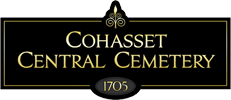Cohasset's Earliest Homes
David Wadsworth
From Savor of Salt: An Anthology of Cohasset History, edited by Jacqueline M. Dormitzer (Town of Cohasset, MA, 2006), pp. 64-66.
People often ask where the first house in Cohasset was built. Here David Wadsworth describes the location of the earliest homes. Interestingly, Lily Pond was the preferred site for some of the pioneers—perhaps because it was a source of fresh water (and also useful for washing sheep) and the land was suitable for farming.
Cohasset’s earliest homes were built shortly after the 1670 land division of the Conahasset uplands. In that year the vacant pastureland of Hingham’s eastern part had been surveyed and parceled out to qualified Hingham property owners. Previously uninhabited land became the site of the first farms and homesteads for second-generation Hingham families.
Of the very first homes in Cohasset, none remain today. Clement Bates’s small house of about 1676 near Lily Pond has vanished, as has Cornelius Canterbury’s. No trace remains of Daniel Lincoln’s 1685 home near the “Plain,” or Common, nor of Israel Nichols’s near Straits Pond—the one moved across the ice of Straits Pond from Green Hill, Nantasket.
Likewise, John Jacob’s first house near the meadow named for him has long since disappeared, as have those of Aaron Pratt and Hezekiah Tower near Lily Pond. The old well of Hezekiah’s father, Ibrook Tower, lies beneath a paved parking area near the junction of Sohier Street and old King Street, and the foundation stones of his home have long since been dispersed.
Cohasset houses from 1700 or earlier [and still existing] number but two. The earliest and best documented is the one built by Joshua Bates in 1695 at [179] South Main Street. From the same period, at least within a few years, is the Richard Tower House, originally located at the west side of the Common but moved to [51] Elm Street in the mid-1800s. Both these early dwellings were built as Colonial farmhouses. By the third decade of the 1700s, larger houses of the half-Colonial and full-Colonial style were being constructed to accommodate growing families.
Thomas James’s 1704 farmhouse “near the brook” may have been the first substantial structure at the site of today’s village center. That early farmhouse remains as a part of the large inn [Red Lion] first operated on the stagecoach line by Thomas’s grandson Christopher. In 1712 Hezekiah Lincoln, Jr., built a home on the highway leading from Hingham to Scituate west of the Common [at 170 North Main Street], just across the street from today’s Little League baseball field. The following year, Joseph Bates constructed a Colonial farmhouse at the north end of the Common [67 North Main Street] where Deer Hill Lane (today’s Sohier Street) joined that early highway.
Within the next fifteen years, homesteads were seen along the several original highways, from Israel Nichols’s on the north [near Straits Pond], to Rev. Nehemiah Hobart’s 1722 house at the Common [19 North Main Street], to those lining King Street, and Prince Joy’s house near the distant part of the road leading to the Beech Woods [389 Beechwood Street].
Conahasset’s earliest highways were those planned by Lieutenant Joshua Fisher in the survey of the uplands made in 1670, plus several preexisting cart paths that became traveled ways. Fisher’s proposed highways included today’s King Street, intended to be the main thoroughfare, and today’s Sohier Street, Pond Street, and the east part of Beechwood Street, called Wood Street. These highways linked together the farms and homesteads of Conahasset and led to the parish and precinct meetinghouse on the Common.
Before 1730 Joshua Burr, Samuel Cushing, and Thomas James, Jr., had built houses at [27, 130, and 250, respectively] King Street; Elisha Lincoln midway at Deer Hill Lane [155 Sohier Street]; Captain John Jacob near Jacob’s Meadow [98 South Main Street]; and John Stephenson and Samuel Orcutt on South Main Street at the beginning of Wood Street [266 and 285 South Main Street, respectively]. With the exception of the house built by Cushing, all these early homes still exist.
By the mid-1700s a number of newer connecting roads . . . had become populated with the same types of sturdy, functional, but esthetically pleasing houses as could be found on the earlier ways. The strong post-and-beam frames of these early homes were destined to last for centuries, barring accident or purposeful destruction. The earliest homes of Cohasset form a unique and valuable part of the historical heritage of our town. They deserve our continued efforts to preserve them.
From David Wadsworth, “Cohasset’s Early Homes: Part of Our Unique Heritage,” Cohasset Historical Society pamphlet. Reprinted by permission of the author.

